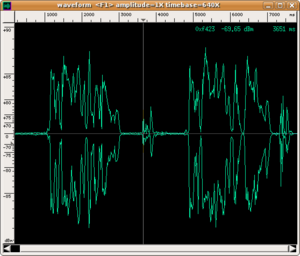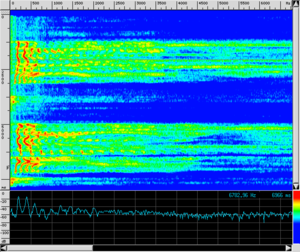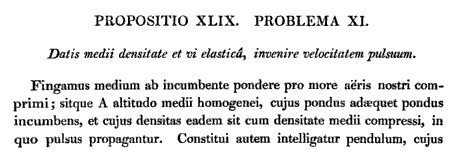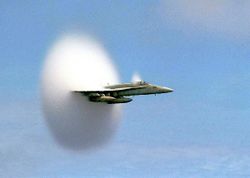Velocità del suono en
Da "Fisica, onde Musica": un sito web su fisica delle onde e del suono, acustica degli strumenti musicali, scale musicali, armonia e musica.
Jump to navigation Jump to searchSound travels quickly: is that a problem?
We all know that sound propagates in the air with a finite speed and that this speed is finite and smaller than that of light. This knowledge is part of our everyday experience that does not need the mediation of complicated experimental devices. In fact, both of these facts have been known since antiquity.
Physics faces a completely different type of problem when it asks:
- to quantitatively determine the speed of sound in various media.
- to provide, based on first principles, a theory that can produce values of the speed of sound in accordance with experimental observations and explain differences in speeds that are observed in different temperature and humidity conditions, as well as and in various media.
- to predict what value the speed of sound will have in media in which it has not yet been measured.
We do not wish to go into detail but to just mention some points that highlight the type of problem that physicists face in simple, yet typical, cases.
The speed of sound: an experimental problem
Speed is the relationship between the amount of space travelled and the amount of time to travel it. The easiest way to measure speed is to measure a fixed distance and the amount of time that it takes sound to travel it.
This problem is rather trivial for the technology of today where people wear precision watches that indicate hundredths of a second and sound sensors (microphones and recording devices) that are just as rapid and precise are available. Moreover, the speed of sound does not seem to be so fast since we can build planes and space ships that are much faster than it.
However, let's go back to the early 17th century. The only acoustic recorder available to us would have been the human ear and the most precise watch would have been based on a recent discovery by Galileo: the law of isochronism of the pendulum. A brilliant Dutch physicist, Christiaan Huygens, was able to find a mathematical formula that linked the time of an oscillation of a pendulum to its length. Too bad that we are not in the second half of that century because, after 1670 and probably thanks to an ingenious English watchmaker (William Clement) who invented the anchor escapement, we all could have had watches that were accurate to the minute [sic] and eventually to the second.
The problem in the 17th century was that the speed of sound was incredibly fast (second only to that of light and it was not clear if that was finite, as the Arabs already knew, or infinite, as Aristotle, Kepler and Déscartes claimed).
- So, with how much precision could we have measured such a speed?
- Newton made incredibly precise measurements (within 1% of the value known today) using the phenomenon of echo in the north cloister of Neville's Court in Trinity College, Cambridge, where he studied (see the photograph the left). He was able to craft a pendulum of such length that its period approximated the back and forth travel time of sound, which was less than a second as the cloister measures about 65 m.
- Can you imagine a way to make that measurement in a smaller space?
- By exploiting the phenomenon of interference with a Kundt tube, we can reduce the dimension of the experimental apparatus to a curved tube a half a metre long.
This story shows how one of the concerns of an experimental physicist is how to measure "something" when the technology for that "something" does not exist yet?
The speed of sound: a theoretical problem
The theoretical problem appears to be even more difficult: if sound is a disturbance that propagates in material media, should we know the forces that act inside the material in detail to be able to describe it? Or does there exist a way to describe the phenomenon on a macroscopic level while ignoring the most minute details of the structure of the medium?
Therefore, we could say that the concern of the theoretical physicist is how to describe "something" when that "something" is not yet known?
Again, Newton was the first to find a brilliant formula for the speed of sound in the air.[1] It is brilliant, even though it is not entirely correct. However, the reasoning behind his formula is extremely acute. Unfortunately, in the early 17th century, thermodynamics had not yet been developed and, therefore, Newton's formula was missing a (adimensional) multiplicative coefficient, the absence of which gave numerical values that were off by about 18%.
A modern version of Newton's reasoning is given below because in this case, more important than the numerical value is the heuristic power of reasoning, which is very inspiring.
- If we slowly compress a volume of air in a undeformable cylinder with a piston, we can see that it resists compression as a spring would do. Air reacts with an elastic force
-
, (1)
where is the variation of volume and is the variation of pressure in the cylinder.
- When the piston is released, the air returns to occupy its original volume. This return is not instantaneous but rather "slowed" by the inertia of the air itself, in other words, by the mass contained in the original volume V0. This is none other than its density
-
. (2)
A mechanical model of sound transmission slowly emerges in which air is seen as an elastic medium, the oscillatory motion of which is determined by the same two properties - elasticity and inertia - that determine the oscillation of a mass hanging on a spring. What is left to understand is how to combine these two properties to obtain a speed. The exact but complex way would be to write the entire equation of motion and solve it. However, we can take the shortcut provided by dimensional reasoning.
The constant K, as is shown in (1), is measured in units of pressure while density is measured in units of mass per volume. The only combination of the two which gives speed as a dimension is:
-
. (3)
Newton's error
The creation of a theoretical formula to explain the speed of sound starting from two simple properties of air is an incredible intellectual feat, and, as we have said, and Newton's intuition on which it is based is correct.
Newton's error was this: the most intuitive way to determine the value of K is to measure the pressure that needs to be exerted on a cylinder of air to obtain a given compression. However, the value of K found in this manner is not the correct value to use in the case of sound.
The reason is due to thermodynamics.
In fact, the compression of air in the piston in laboratory conditions is performed slowly and the work done on the gas has time to convert into heat and to transfer from the gas to the container walls dispersing in the environment. The compression is isothermal because the is no change in the gas temperature. In the case of sound, this is generally not so. When a 500 Hz sound travels through air, each compression lasts for only one millisecond. In these conditions, the work done on the gas does not have enough time to transfer to the container in the form of heat and remains in the gas in the form of the kinetic energy of its molecules. This is called adiabatic compression.
The kinetic energy of the air molecules resists the compression more strongly with the results being that adiabatic compressibility is greater than the isothermal one used by Newton. Precisely,
- .
This means that air acts as a more rigid spring to the passage of sound. Thermodynamics can also give us a theoretical expression for the coefficient of proportionality 1.4, which until now, we have treated as a mere experimental datum.
- You can find a less elementary lecture about the equation of sound in gases on the page regarding the equation of sound waves.
Let us bust a few myths about sound in air
Paradoxically, it often happens that the more a phenomenon is curious, interesting and accessible to all, the more intuitive and imaginative explanations of it flourish and spread. All of these explanations have the right to be formulated, as they are produced by activity of the human mind, which is always searching for the "why" of things. However, one of the goals of the scientific method is to define the "method" to use to verify (or falsify) the correspondence between theories and experimental observation.
Here are a few statements on the speed of sound that we have collected, which give an erroneous theoretical interpretation for primarily correct experimental observations.
- Sound travels more rapidly in denser media. This is demonstrated by the fact that sound travels more slowly in air than in water and more slowly in water than in iron.
- The speed of sound in the atmosphere diminishes with altitude because the air pressure diminishes.
- Sounds are better heard when the listener is downwind with respect to the transmitter because sound travels faster with the wind than against it.
We now offer the correct explanations.
Myth no. 1
Sound travels more rapidly in denser media. This is demonstrated by the fact that sound travels more slowly in air than in water and more slowly in water than in iron.
If you followed Newton's reasoning summarised in the previous section, you should have immediately understood where the error lies in statement no. 1 and why the example given does not demonstrate it.
Dimensional analysis along with the mechanical model of oscillation tells us that the speed of sound in any medium can be represented by such a ratio as
- ,
where κ represents the elasticity of the medium and ρ its density.
- The 'elasticity is represented by the numerator, therefore, we expect the speed of sound to increase in more rigid media with the same density.
- The density is represented by the denominator, therefore, we expect the speed of sound to decrease in denser media with the same elastic constant.
One of the two parameters must be fixed in order to express the speed of sound as a function of the other. If we compare air and water, we mix up the two variations because air and water have not only very different density (by a factor of about 1,000) but also completely different elastic constants (by a factor of about 10,000). Air can even be compressed by hand without excessive force in a syringe while water has a very low compressibility. We have never heard of "compressed water", only of "compressed air". The same goes for the comparison between water and iron. The speed of sound in a solid is faster because, even if it is true that a solid is denser, its rigidity in proportion, is greater than that of water.
All of the previous reasoning can be applied to homogeneous (and infinite) blocks of material, provided room temperature is kept constant, and to the only mechanical waves that propagate in all three media, which are longitudinal elastic waves.
For the record, here are the relevant values for the three materials at room temperature and pressure.
|
(1) Indicates the adiabatic compressibility at room conditions for air and water; Young's modulus for iron. The latter must be raised to a value of 276 if we consider the propagation of plane waves in an infinite medium instead of in a thin bar (see the page on the wave equation and related pages). |
Myth no. 2
The speed of sound in the atmosphere diminishes with altitude because the air pressure diminishes.
Now that we have a mechanical model and a formula to determine the speed of sound in air, we can study how it depends on the properties of air such as pressure, temperature, density, etc. and, therefore, verify the real reason for the decrease of the speed of sound with altitude.
Again, we will get our answer from thermodynamics, which provides us with:
- a equation of state for perfect gases (if air is such)
- ;
- an expression for adiabatic compressibility
- .
The equation of state can be written so that it includes the density ρ instead of the number of moles n and the volume V. In fact, given M the molecular mass of air[2]
-
, (4)
where kB is the universal Boltzmann constant (1.38 ×10-23 J/K).
Substituting in (3) we deduce the expression
or, as long as air can be considered an ideal gas
- the speed of sound does not depend on either its density or its pressure but
- solely on its temperature.
We can now see that the first part of statement no. 2 is acceptable. Normally, the speed of sound diminishes with altitude, at least for the lowest layers of the atmosphere and in the absence of thermal inversions (see the page on sound refraction) but the reason is different. In fact, we have seen that the speed of sound does not depend on air pressure but only on air temperature. If the speed of propagation diminishes with altitude it is only because air temperature usually diminishes with altitude. The decrease in pressure occurs but it has no influence on the speed of sound because it is compensated by an equal decrease in air density. In formula (3), the pressure and density of the gas appear respectively at the numerator and denominator and, therefore, their variations cancel leaving only the dependence on temperature.
We can also change the temperature T from degrees Kelvin to the more familiar degrees Celsius t and obtain the practical formula directly in m/s
Myth no. 3
Sounds are better heard when the listener is downwind with respect to the transmitter because sound travels faster with the wind
Again, we have fact with an empiric base because sounds are heard better downwind than upwind. Even the expression "sound carried by the wind" has entered into everyday language. However, an examination of the orders of magnitude of the two speeds is enough to make us doubt the suggested explanation, which is based on the theorem of addition of velocities.
- The speed of sound is about 340 m/s in standard conditions.
- The speed of wind normally has a value between 100 and 1,000 times less. A speed of about 40 knots (about 20 m/s) is considered "force 9" on the Beaufort scale and is classified as a "strong gale". During a hurricane, the wind can reach a speed of 80 knots (30 m/s) but in that case, the observation cannot be applied because the only perceptible sound would be the noise of the devastation. We would be at "force 12", which is the maximum observed.
The correct explanation of this phenomenon is associated with the concept of refraction. This depends on the variation of wind speed with elevation from the ground and not with the theorem of addition of velocities.
For a more detailed discussion, go to the page on sound refraction.
Other gases
The same formula (4) allows us to compare different gases, once we have fixed the value of pressure. This time, what remains is the dependence of the adiabatic coefficient γ on the molecular mass m of the gas, as well as on the temperature. From (4) we can deduce, if all other properties are the same, the speed of sound is inversely proportional to the molecular mass of the gas in which it propagates. Below is a table in which gases are ordered based on their molecular mass.
However, remember that when different gases are compared, we must take into account the adiabatic coefficient γ, which depends on the thermodynamic properties of the gas. For monatomic gases (like Helium) γ has a theoretical value of 5/3, while for diatomic gases (like Nitrogen, Oxygen and, in media, air) it has a theoretical value of 7/5.
| gas | molecular mass (g/mol) | density(1) (kg/m³) | adiabatic coeff. γ | speed of sound(2) (m/s) |
|---|---|---|---|---|
| Helium (He) | 2 | 0.18 | 1.66 | 1030 |
| Nitrogen (N2) | 28 | 1.25 | 1.40 | 353 |
| Air | 29 | 1.20 | 1.40 | 344 |
| Oxygen (O2) | 32 | 1.43 | 1.40 | 330 |
| Carbon dioxide (CO2) | 44 | 1.98 | 1.30 | 279 |
| Sulphur hexafluoride (SF6) | 146 | 6.07 | 1.08 | 145 |
(1) 0° C, at sea level; (2) at 27° C, at sea level
The table shows us that the speed of the propagation of sound in Helium is about triple that of air, while in Sulphur hexafluoride, it is less than half of that of air. In both cases, we can qualitatively verify the effect on the human voice, as is illustrated in the next paragraph.
Voice and the speed of sound
The game of breathing helium from a balloon to get a silly-sounding voice is well known and very common. Let us try to figure out an explanation for this phenomenon.
- The frequency of vocal cords is not noticeably modified by the surrounding gas. Vocal cords continue to vibrate at about the same frequency in Helium as in air. This frequency is basically determined by the muscle tension that drives them.
- However, the voice will seem to have acquired a higher timbre and the words will be pronounced strangely. How is this possible?
- The reason is because, while vocal cords in the larynx are the source of sound oscillation, they are not the only thing that determines voice timbre. For example, we could not distinguish one vowel from another were it not for the ample use of the system of resonating cavities with varied geometric shapes that make up our vocal tract and in particular our mouth. Vocal cords produce a wave with a complex shape composed of a certain spectrum of harmonics but the voice is modulated by filtering due to the resonances of the pharynx, mouth, nasal cavities, etc. The geometry of the resonating cavities does not directly select the frequencies but rather the wavelengths. The selection of resonance frequencies happens because frequency is the ratio of wavelength to speed that in Helium is increased by a factor of about 3.
- Therefore, the effect of Helium does not modify the frequency of voice harmonics, it shifts the resonance frequencies of the mouth and other cavities to higher values.
- The result is that the 'amplitude relative to the various harmonics is changed. Higher harmonics that do not have a large amplitude in air become more prominent in Helium. Since the specific shape of vowels is determined by several spectral regions (which make up the so-called "formants"), some words may even become barely intelligible.
| wave form | sonogram | Audio | |
|---|---|---|---|

|

|
|
Much less common is the opposite effect, a gas that lowers voice timbre. In fact, most heavy gases are toxic. This can be seen in the following videos created for the Physikshow by the Physics Institute of Bonn University.
| A spectacular demonstration of the greater density of SF6 with respect to air. The transparent box was filled with SF6. The gas, which is about five times denser than air, with no turbulence present deposits on the bottom and an aluminium boat can be floated on top. The boat can be sunk by filling it with the same gas. | The inhalation of SF6 shows that the voice timbre is lowered in register, the opposite of what happens when Helium is inhaled, which makes the voice similar to Donald Duck. In both cases, a comic effect is guaranteed. |
- For a more thorough examination of the mechanism of voice production, see the page on the human voice.
- To understand how the resonance frequencies of a cavity depend on the speed of sound, see the pages on eigenfrequencies and normal modes.
- In wind musical instruments, in which the source of the sound oscillation comes not from a vibrating cord but from an air column inside the instrument bore set into vibration by a musician, modifying the gas within the bore directly induces a change of frequency in the note emitted. For example, if an organ pipe that is built to emit the note LA with a frequency of 440 Hz were filled with Helium, it would emit a frequency sound triple that (remember that the speed of sound in Helium is about triple that of air).
Dispersion
- Along with being breathable, air has another pleasant property. It is basically a non-dispersive medium with respect to sounds of audible frequency.
- This means that all audible sounds travel in air with the same speed regardless of their frequency.
This is a very important property because it guarantees that sound waves maintain their shape during propagation and allows for "voice" communication. If a sound changed shape, for example an "a" emitted by a speaker changed into a "u" during its travels and was received by the listener as such, this would obviously cause problems in communication.
Carbon dioxide, however, is a dispersive medium with respect to sound and this demonstrates that our calculations about speed need to be fine-tuned. However, the effect is only observable at ultrasonic frequencies and, therefore, does not influence audible communications.
Let us now leave our discussion on dispersion to a dedicated page (dispersion). It will return in the following paragraphs on water.
The speed of sound in water
The precise determination of the speed of sound is extremely important for all marine applications including oceanographic acoustics, sonar and marine ethology. For example, acoustic navigation is still of fundamental importance to submergibles and submarines because most radio waves cannot pass from air to water and, therefore, normal radio and GPS transmissions do not work underwater.
Transverse waves are not possible in liquids because a liquid does not offer elastic resistance to shear forces and, therefore, it does not have transverse elasticity. It has an highly inferior compressibility with respect to gases and, therefore, it behaves as a much more rigid elastic medium.
The speed of sound is still calculated for water in standard conditions using a formula similar to Newton's for air, however, remember that water density is about 1,000 times greater than that of air, while its compressibility is about 10,000 times less. The number that is obtained for distilled water at 25° C and room pressure is
However, the conditions of seawater are subject to many variables: its temperature is subject to great variation due to depths, currents, latitudes and seasons; its salinity greatly changes local density; and finally, its pressure increases with depth and, therefore, so does its density (even if only slightly).
All these variables make the ocean a non-homogeneous medium and the speed of sound can also change from place to place due to the phenomenon of refraction.
A known and particularly important effect is the existence of a privileged "channel" in the ocean at an approximate depth of 750 m that can conduct underwater sound at great distances like a real waveguide. For further study, see the page on sound refraction.
And in solids?
In solids, the story is a bit more articulated because, while liquids and gases have only compression elasticity, solids have elastic forces also for traction and shear stresses. Consequently, not only can (longitudinal) sound waves propagate in a solid but also other types of elastic waves can too.
For further discussion, read the paragraph on the speed of mechanical waves.
Beyond the wall of sound
With the discovery of firearms, the speed of solid bodies in air has been greatly increased. Many portable weapons shoot projectiles at speeds from 200 to 300 m/s while cannons and missiles easily surpass 1,000 m/s. At these speeds, the hydrodynamic effects of air on projectile motion cannot be ignored or approximated as "viscous friction" and an entire branch of physics is dedicated to their study.
The advent of jet propulsion has further raised the limit forcing engineers to face serious problems in designing materials and structures able to withstand huge dynamic stresses. This has also made the phenomenon of the "supersonic boom" very familiar to us. For an illustration of the phenomenon, go to the page on the Doppler effect.
The space age brings even newer problems: the Space Shuttle re-enters the atmosphere at a speed about 25 times greater than that of sound. At this speed, friction causes heat to develop and makes air undergo a phase transition into a high-temperature, ionised plasma forcing the use of a thermal shield to prevent the instantaneous destruction of the spacecraft.
In aeronautics, it is usual to measure the air speed of an aircraft on the Mach scale. Mach 1 is equivalent to the speed of sound.
| number of mach | regime | physical phenomena |
|---|---|---|
| subsonic | air friction resists motion and can generate hydrodynamic forces such as lift, which makes airplanes fly. | |
| transonic | new hydrodynamic phenomena appear, such as the sudden forming of condensation clouds or choking of the flow, described in this page from NASA | |
| supersonic | non-linear terms in the wave equation become important and we can no longer apply the superposition principle. New elastic waves appear with different properties than sound waves, one being shock waves. another NASA page including an applet to calculate the wave shape. | |
| high supersonic | Thermodynamic effects on air compression become relevant: the aircraft exchanges heat with air. | |
| hypersonic | High temperature can change the aggregation status of air. |
Links
- In this page from the journal Scientific American, a brief article (in English) reviewing several methods used to measure the speed of sound and light.
- ↑ Sir I. Newton, Philosophiae Naturalis Principia Mathematica, II, 49. You can read the original text in Latin from an 1833 edition here. Google Books
- ↑ We clearly know that does not exist such a thing as an air molecule, since air is a mixture of gases: about 78% Nitrogen, 21% Oxygen, and the remaining 1% other gases. Therefore M is meant to be the average molar mass of the mixture























